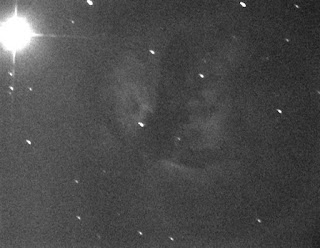These are images of the Flame Nebula (NGC 2024). The bright star at the top of the image is Alnitak, which sends ultraviolet light into the Flame. This knocks electrons of the masses of hydrogen gas; the glow of the nebula is mostly from the recombining electrons and hydrogen. The nebula is part of the huge Orion Molecular Cloud--a star forming region. Note also the lanes of dark gas and dust in these images. The integrations were all around 20-30 seconds long with dark frame processing enabled.
The trials, tribulations and small triumphs of a Charlotte, NC astronomer imaging under Bortle 8/9 skies.
Thursday, January 28, 2016
The Flame Nebula (NGC 2024) 1.27.16
I took advantage of some breaks in the clouds to do some imaging with the VRC and my DSm camera last night. The sky was a little hazy and bars of cloud moved over the imaged areas from time to time, but, as there was no moon, conditions were actually better than they were the last time I imaged a couple of days ago.
Subscribe to:
Post Comments (Atom)
16 hour integration of the Heart Nebula with the Dwarf 3 telescope
The Heart Nebula can be a challenging object due to its low surface brightness, especially in my neighborhood where I image under Bortle 8/9...

-
I had a couple of emails asking how to defork an ETX telescope. The ETX 90 and ETX 125 were optically superb scopes, but the mounts left a...
-
The ZEQ25 doing its stuff on a cold night--imaging the Orion Nebula with an 8 inch f/4 astrograph. Note the lovely Christmas rug :) As ...
-
One of the great things about being a part of an online community of people with similar interests is that you learn a lot from people who a...






No comments:
Post a Comment